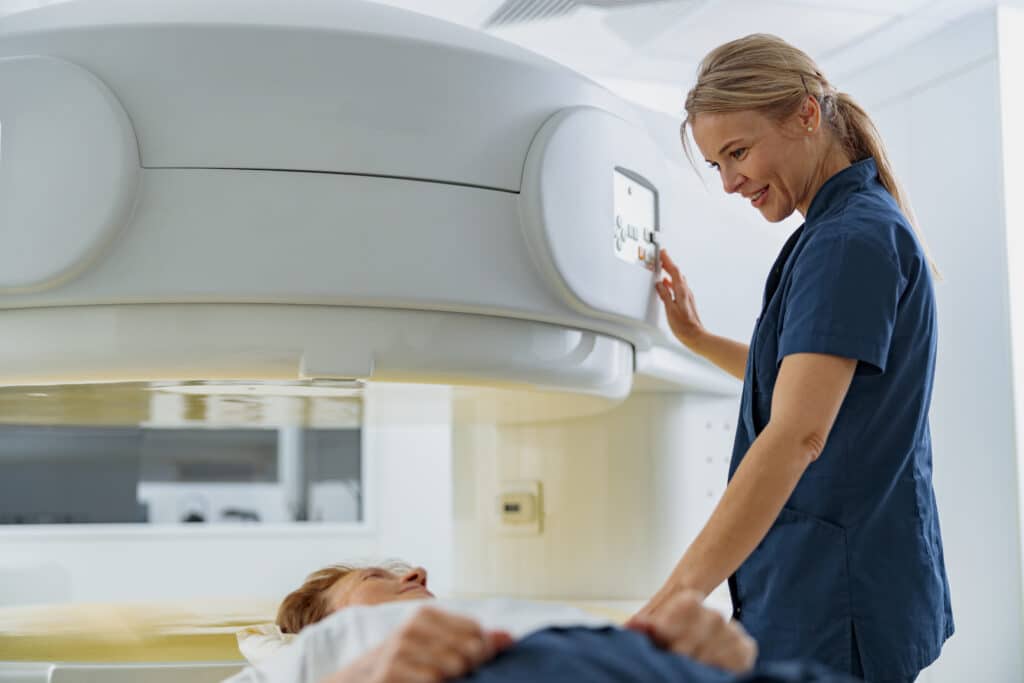Radiology medical billing is the process of submitting claims and receiving payment for medical services provided by radiologists, who are specialized physicians that diagnose and treat medical conditions using imaging technology. Just as radiology covers a broad range of procedures and diagnoses, billing services for this field involve a complex system of coding and billing rules that can be difficult to navigate without proper expertise.
This article gives an overview of radiology medical billing and explain workflow steps and challenges for radiology billers. We’ll also offer tips to help radiology providers streamline the billing process and optimize revenue.

Radiology Medical Billing: Key Workflows, Codes, and Tools
Looking to improve your radiology medical billing workflow? This deep-dive guide covers everything from CPT coding and ICD‑10 diagnostics to claim submission, reimbursement hurdles, and software solutions—all tailored for imaging specialists. Learn how to:
- Avoid costly billing mistakes like undercoding and upcoding
- Navigate the split between professional and technical components
- Speed up claim processing and boost first-pass acceptance
- Leverage automation, EHR integration, and modern RCM software
What You’ll Learn:
- Proven strategies and tools to enhance revenue cycle efficiency
- Radiology billing essentials—including CPT (Current Procedural Terminology) codes and how they differ from ICD‑10 diagnostic codes
- Step-by-step workflows from pre-authorization to claim follow-up
- Common pain points—like modifiers, denials, and clean claim best practices
Radiology Medical Billing Guidelines
Most radiology services consist of two components: professional and technical. The professional component refers to expertise provided by the radiologist, including supervision during imaging, interpretation of the images, and written reports. The technical component includes the equipment, supplies, and other costs related to the performance of the exam. Following radiology billing guidelines for both components is crucial for successful reimbursement.
Radilogy medical billing relies on a standardized system of codes to identify and describe radiological procedures, diagnoses, and treatments. Two of the most important coding systems for radiologists are the Current Procedural Terminology (CPT) and the International Classification of Diseases, Tenth Revision (ICD-10). The ICD-10 has two subsets, the Procedural Coding System (ICD-10-PCS) for inpatient settings and the Clinically Modified (ICD-10-CM) code set for outpatient settings—radiology medical billing uses both of these.
Radiology CPT Codes
Billing services use CPT codes to describe procedures and services performed by healthcare providers. Radiologists use thousands of CPT codes, depending on the type of imaging study or procedure performed. Nuclear medicine alone consists of 2,000 medical codes (78000—79999), while broader categories like diagnostic radiology include 6,500 medical codes (70000—76,499). Below are a few more examples.
- Diagnostic Ultrasound 76500—76999
- Radiologic Guidance 77001—77032
- Breast, Mammography 77051—77059
- Bone/Joint Studies 77071—77084
- Radiation Oncology 77261—77999

Radiology ICD Code
ICD-10 codes, on the other hand, describe diagnoses and medical conditions. Radiologists use ICD-10 codes to indicate the reason for a patient’s imaging study, such as a specific medical condition or symptom. For example, if a patient is undergoing a CT scan to investigate possible lung cancer, the provider would use the ICD-10 code for lung cancer as the primary diagnosis code.
Additional Medical Coding
In addition to CPT and ICD-10, radiologists may also use Healthcare Common Procedure Coding System (HCPCS) codes for medical equipment, supplies, and services not covered by CPT codes.
Interventional radiologists, who use imaging technology to conduct minimally invasive procedures, can have different billing concerns than those of traditional radiologists. Some of their medical codes fall under the surgical section of CPT codes, as opposed to the diagnostic codes used by traditional radiologists. Therefore, interventional radiologists must be well-versed in both the diagnostic and surgical coding systems to ensure accurate billing. Below are a few examples.
- Mechanical Thrombectomy: 34201, 34421, 34490
- Biliary Drainage: 47510, 47511, 47530
- Cholecystostomy Tube Placement: 47490
- IVC Filter Placement: 37620
- Biliary Stone Removal: 47630
Accurate medical coding is essential for successful reimbursement, as incorrect or incomplete coding can lead to claim denials or delayed payments. Radiologists must ensure they are using the correct codes for the services they provide, including any modifiers or additional codes as necessary.
Radiology Medical Billing Step by Step
Step 1: Pre-Authorization and Insurance Eligibility Verification
Before providing any radiology services, it’s important to obtain pre-authorization from patients’ insurance providers, who require documentation to demonstrate medical necessity for the procedure. Billing staff also needs to verify the patient’s insurance eligibility and coverage to determine any out-of-pocket expenses they may be responsible for.
Step 2: Rendering Services and Capturing Charges
Once pre-authorization is obtained and insurance eligibility is verified, the radiologist performs the procedure. It is important for providers to keep detailed records throughout a patient’s visit, in order to capture charges and eventually receive reimbursement for each service provided.
Step 3: Claims Submission
After an appointment, a medical coder reviews the patient’s medical documentation and classifies their condition in industry-recognized alphanumeric codes such as CPT and ICD-10. Billing staff then itemizes these codes in a payment claim and submits the claim to the patient’s insurance provider.
Along with the insurance claim, radiology medical billers must also provide detailed information about the procedures that were performed, such as the types of imaging used, the body part imaged, and contrast agents administered. Insurance payers use this data to verify that the procedures were medically necessary.
It’s important to submit claims correctly and in a timely manner, since some insurance companies have filing deadlines that, when missed, nullify coverage. Effective management of the revenue cycle prevents unnecessary income loss.

Step 4: Payment
Once the insurance provider receives a radiology claim, they will review it and determine the appropriate payment amount owed. If a patient’s insurance plan does not cover the entire cost of a procedure, radiology medical billers must send invoices to patients for the remaining balance and follow up for payment collection.
Step 5: Data Reporting
Finally, the radiology billing staff must report all data related to the services provided, including any diagnosis codes, CPT codes, and modifiers used. This data is used for tracking purposes and may also be required for regulatory compliance.
Challenges of Radiology Medical Billing
Many of the challenges in radiology billing stem from the misassignment of medical codes, which can lead to payment denials or uncaptured revenue. Here are a few examples.
Professional vs. Technical Modifiers
Radiologists need to use special modifiers to distinguish between the professional and technical components of their services. Sometimes, a radiology procedure might be coded in different ways depending on how it’s being billed.
For example, the CPT code 76700 denotes an abdominal ultrasound. If a radiologist performs an ultrasound scan of a patient’s abdomen in their private office, they would bill for the professional component of the service using the CPT code 76700-26. The “-26” modifier indicates that only the interpretation and report of the scan are being billed, not the actual performance of the scan.
If the same ultrasound scan of the abdomen is performed in a hospital or imaging center, however, the facility would bill for the technical component of the service using the CPT code 76700-TC. The “-TC” modifier denotes that only the technical portion of the service is being billed.
Notably, the total reimbursement for the service may be different depending on who is billing for the professional and technical components of the service. This is because insurance companies and payers may have different reimbursement rates for different types of providers and facilities.
Undercoding in Radiology Billing
Radiology medical billing is susceptible to undercoding, or billing for a lower-level service than was actually provided or documented. This can result in lower reimbursement rates than are appropriate for the service provided and lost revenue for radiology providers.
Here’s an example of undercoding in radiology billing:
A patient undergoes a CT scan of the abdomen and pelvis with the use of a contrast agent, which is billed as CPT code 74183. Undercoding would occur if the radiology center billed for a non-contrast CT scan (CPT code 74177), which gives a less detailed image and is not always sufficient for diagnosis.
If billed incorrectly, the provider would lose out on reimbursement for the contrast agent and higher-quality scan, though the results are likely more useful for other providers down the line.
Upcoding in Radiology Billing
Ironically, upcoding, or billing for a higher-level service than was actually provided, is also a known problem in radiology billing. Upcoding can result in higher reimbursement rates than are appropriate for the service provided and is considered fraudulent if done intentionally.
Here’s an example of upcoding in radiology medical billing:
A radiologist conducting a limited ultrasound exam would use CPT code 76775. The limited exam typically involves a quick scan of a specific body part to assess for any abnormalities or changes. Upcoding would occur if the radiology center billed for a more extensive ultrasound exam than was actually performed, such as a complete abdominal ultrasound (CPT code 76700) or a pelvic ultrasound (CPT code 76856), both of which involve a more thorough examination of the body than a limited ultrasound.
Upcoding is a serious violation of medical billing regulations and can result in fines, legal action, and damage to a provider’s professional reputation. Radiology billing professionals must be careful to accurately document and code the services provided to ensure that claims are submitted correctly and ethically.

Tips for Streamlining Radiology Medical Billing
A streamlined medical billing process can help radiologists get paid appropriately for the services they provide. Though radiology medical billing is complex, following these key tips can expedite the process and optimize revenue.
Understand the Radiology Coding System
Radiology medical billing requires a thorough understanding of CPT and ICD codes related to the specialty. Maximum reimbursement depends on accurate medical coding, because insurance payers may have different reimbursement rates for different types of radiology providers.
Verify Insurance Coverage
Before providing any services, it’s important to verify the patient’s insurance coverage and eligibility. This way, providers know in advance whether patients will have out-of-pocket expenses, and both parties can be prepared for the billing process later on.
Ensure Accurate Documentation
Before submitting a claim to payers, ensure all documentation related to the patient’s medical history, examination, and treatment is complete and accurate. This includes keeping track of all diagnosis codes, CPT codes, and modifiers. It’s important to have a system for organizing and managing this documentation, not only for verification by insurance companies but also for compliance audits by regulatory agencies.
Submit Radiology Claims On Time
Submit claims as soon as possible to avoid any delays in payment. Insurance payers often have deadlines for filing claims after patient visits. If billers and coders miss these deadlines, their employer may not receive reimbursement for services. Given the daily influx of new cases and different deadlines from various insurance companies, it’s all too easy for payments to slip through the cracks.
Stay Up to Date with Regulations
The medical billing landscape is constantly changing, with new regulations and policies being introduced regularly. The CPT and ICD-10, for example, are both reviewed and subject to update annually. Federal and state regulations can also change at any time, and providers must maintain compliance on both levels. Stay up to date with these changes to avoid delays in payment.
Use Radiology Medical Billing Technology
Recent technological innovations have made medical billing much more efficient. Electronic health record (EHR) systems, for example, keep medical records organized and accessible for easy reference. This is especially helpful for radiology billers who access multiple scans and reports for hundreds of payment claims each day.
Medical billing software, meanwhile, automates certain tasks to reduce errors and save providers time in the billing process. Some medical billing services allow users to create and send multiple claims at a time so workers are not completing such high volumes of paperwork by hand. For radiology billing in particular, billing software can flag inconsistencies before claims are sent to insurance companies, reducing the likelihood of a denied claim.
Hire a Professional Medical Billing Company
Some providers may find it difficult to manage their radiology billing in-house, since medical coding for the specialty is extremely complex. Practices with a high volume of radiology billing can consider hiring a professional medical billing company. Outsourcing to specialized experts can save providers time and resources while ensuring that billing is accurate and compliant with regulations.

Medical Billing Software for Radiology
Radiology medical billing is a complex process that requires specialized knowledge to ensure successful reimbursement for services provided. With the right medical billing software, radiologists can focus on providing high-quality patient care while maintaining a successful and profitable practice.
CollaborateMD streamlines the medical billing process so radiology practices get paid, with features such as electronic claims submission, automated posting of payments, and real-time eligibility verification. Our platform also includes tools for managing patient billing, appointment scheduling, and financial reporting.
By following guidelines and best practices, such as understanding the coding system, verifying insurance coverage, and submitting claims in a timely manner, radiology practices can streamline the billing process and maximize their revenue.
Learn more about how CollaborateMD’s medical billing software can improve efficiency and accuracy in the radiology billing process. To see what makes our platform the choice of thousands of practices in our 20+ years of business, schedule your demo today!





